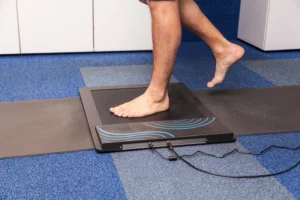Introduction: Understanding Biceps Tendonitis
Biceps tendonitis, a common injury among individuals with shoulder pain. This condition, characterised by pain and inflammation in the tendons that attach the biceps muscle to the shoulder and elbow, can hinder daily activities and impede athletic endeavours. In this comprehensive guide, we’ll delve deep into the world of biceps tendonitis, exploring its causes, symptoms, treatment options, and preventive measures. Whether you’re a gym enthusiast, a sports professional, or simply have a sore shoulder this guide aims to equip you with valuable insights to tackle biceps tendonitis head-on thus helping with shoulder pain in Paisley.
Anatomy and Function of the Biceps Muscle
Before we plunge into the intricacies of biceps tendonitis, it’s essential to understand the anatomy of the biceps muscle and its crucial role in upper body movement. The biceps muscle, often referred to as the “biceps brachii” or simply “biceps,” is a prominent muscle in the human arm. It is a two-headed muscle located on the anterior (front) side of the upper arm. The biceps muscle is responsible for several important functions, including flexing the elbow joint and supinating the forearm (rotating the palm upward).
Here is an overview of the anatomy of the biceps muscle:
- Two Heads: The biceps muscle has two heads, which give it its name “biceps” (Latin for “two heads”). These two heads are:
- Long Head: The long head originates from the supraglenoid tubercle of the scapula (shoulder blade) and runs down the upper arm.
- Short Head: The short head originates from the coracoid process of the scapula and runs alongside the long head.
- Insertion: Both heads of the biceps muscle come together and insert into a common tendon, known as the biceps brachii tendon or the bicipital tendon. This tendon attaches to the radial tuberosity of the radius bone in the forearm.
- Function: The primary function of the biceps muscle is to flex the elbow joint, which means it is responsible for bending the arm at the elbow. Additionally, it plays a role in supinating the forearm, turning the palm upward.
- Innervation: The biceps muscle is innervated by the musculocutaneous nerve, which arises from the brachial plexus.
- Blood Supply: The biceps muscle receives its blood supply from several arteries, including the brachial artery and its branches.
- This muscle is responsible for both elbow flexion and shoulder joint stability, making it a key player in various activities such as lifting, throwing, carrying and reaching.
Unravelling Biceps Tendonitis Causes
While the exact cause of biceps tendonitis can vary from person to person, it often arises from repetitive strain, overuse, or sudden increases in physical activity. Poor lifting techniques, improper warm-up routines, and inadequate rest periods can contribute to the development of this condition. Furthermore, age and pre-existing shoulder issues may increase susceptibility to biceps tendonitis.
Recognizing the Tell-tale Symptoms
Early recognition of biceps tendonitis symptoms is crucial for prompt intervention. Individuals with this condition may experience localized pain at the front of the shoulder or elbow, particularly during overhead movements or activities that involve forceful arm flexion. Swelling, tenderness, and a sensation of snapping or popping may also be present.
Diagnosing Biceps Tendonitis
If you suspect biceps tendonitis, consulting a healthcare professional is imperative. A thorough physical examination, coupled with a medical history review, can aid in diagnosis. In some cases, imaging techniques such as X-rays or MRI scans may be employed to visualize the affected area, helping to rule out other potential causes of pain. The best and easiest way to diagnose this conditions is by seeing a health professional such as a physiotherapist.
Nipping It in the Bud: Initial Treatment Strategies
Once diagnosed, early intervention can significantly expedite recovery. Rest, ice, and over-the-counter anti-inflammatory medications can help alleviate pain and reduce swelling. Implementing modifications to daily activities and avoiding movements that exacerbate symptoms can also aid the healing process.
Delving Deeper into Treatment Approaches
For persistent cases of biceps tendonitis, a multifaceted treatment approach may be necessary. Physical therapy, under the guidance of a trained professional, can help strengthen the surrounding muscles, improve flexibility, and correct movement patterns that contribute to the condition. Additionally, modalities such as ultrasound and therapeutic exercises can promote blood flow and tissue repair.
The Role of Ergonomics and Prevention
Preventing biceps tendonitis begins with proper ergonomics and technique. Whether at the gym, on the field, or in the workplace, maintaining proper posture and using appropriate equipment can significantly reduce the risk of developing this condition. Gradually increasing exercise intensity, incorporating adequate warm-up and cool-down routines, and allowing sufficient rest between workouts are key preventive measures.
When Surgery Becomes an Option
In rare instances where conservative treatments prove ineffective, surgical intervention may be considered. Procedures such as tenodesis, which involves reattaching the biceps tendon to a different location, or tenotomy, where a portion of the tendon is removed, can be explored. However, surgery is typically reserved for severe cases and is carefully evaluated by medical professionals.
Embracing Long-Term Recovery and Beyond
Recovery from biceps tendonitis is a gradual process that requires patience and commitment. As symptoms subside, gradually reintroducing activities and exercises is crucial. Adhering to a well-rounded fitness routine that includes strength training, flexibility exercises, and adequate rest can help maintain the health of the biceps tendons and prevent future recurrences.
Conclusion: Overcoming the Hurdle of Biceps Tendonitis
In the pursuit of arm excellence, navigating the challenges of biceps tendonitis is an essential part of the journey. By understanding the causes, recognizing symptoms, seeking timely treatment, and adopting preventive measures, individuals can conquer this condition and continue their pursuit of physical prowess. Remember, your arm’s potential is vast, and with the right knowledge and care, you can overcome the ache and reach new heights of strength and performance. We at All Out Physiotherapy are experts in shoulder pain and have around a decades experience in dealing with simple and complex shoulder conditions. If you have any concerns about your shoulder then do not hesitate to book in with us.


